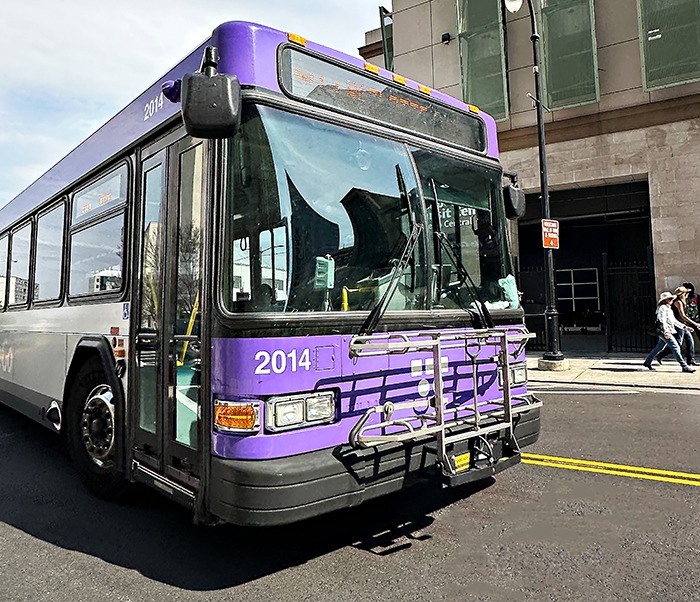
In This Blog
- WeGo Transit modernizes operations with Vontas to support Nashville’s growing ridership and improve fleet efficiency.
- GPS challenges at the downtown transit center led to unreliable tracking due to construction and building materials.
- Vontas OnSite was expanded beyond the yard to enable real-time vehicle tracking inside the multi-level facility.
- Phased rollout and training ensured smooth adoption, with close collaboration between WeGo and Vontas throughout.
- Enhanced tracking improves service, enabling better dispatching, accurate arrival predictions, and a smoother rider experience.
The Nashville WeGo Public Transit serves a fast-growing city with 180 fixed-route buses, 90 paratransit vehicles, and nearly 30,000 daily passengers. Keeping pace with this growth requires a dedicated focus on innovation, especially when it comes to fleet management and service reliability.
Since 2014, WeGo has partnered with Vontas to improve productivity and maintain a more efficient fleet. The agency was able to successfully streamline operations and enhance service with Vontas’ CAD/AVL and yard management systems. But in 2022, WeGo’s leadership saw an opportunity to take their efficiency even further by solving a persistent challenge at their downtown transit center.
Expanding Beyond the Yard
Frequent downtown construction near the center created major congestion, causing unpredictable travel times and increasingly complex schedule management.
“We were looking at other ways that we could still deliver customers a reliable service that doesn’t necessarily rely so heavily on a strict schedule,” said Dan Freudberg, WeGo’s Deputy Chief Operating Officer of Operations Systems.
The design of WeGo’s downtown transit center also worsened the issue. The multi-level facility was built with heavy concrete and steel, which blocked GPS signals and created an “urban canyon effect.” Without reliable location data, it was nearly impossible to accurately track when buses departed, throwing off arrival predictions for passengers.
“When our CAD/AVL’s GPS is blocked by all the cement and the steel, it can’t see the sky anymore, it can’t communicate with the satellites and that location is no longer accurate,” said Andrea Costa, Product Manager at Vontas.
Rather than accept these limitations, WeGo and Vontas collaborated on a new idea: expand the Vontas yard management system beyond the traditional bus yard and into the passenger transit center itself.
Vontas OnSite Meets the Challenge
Adapting OnSite to a multi-level facility required careful planning. First, Vontas surveyed the entire building to design an installation plan that accounted for the structure’s layout and materials. Every antenna needed a clear line of sight to vehicle tags to ensure precise tracking.
“The first step is a very complex process of planning where everything is going to be installed based on that mapping and architectural layout,” Costa said. “That helps us come up with an initial concept of how many antennas we will need to achieve the maximum amount of coverage.”
Once the design was finalized, third-party experts completed the installations. The antennas and tags were integrated into WeGo’s existing CAD/AVL system, delivering a real-time view of vehicle departures and arrivals, even in areas where GPS alone failed.
“What interested us about the new solution was that it was a true vehicle tracking solution where we could see where vehicles were at all times on a map as well as see whether they were occupying a particular parking spot or a particular bus bay,” Freudberg said.
Careful Integration and a Phased Rollout
Vontas’ approach to customer training and system integration was phased and hands-on. During installation, a few vehicles were equipped with the new technology to allow key WeGo project team members to learn the system gradually.
“Not the entire staff, but just a few key members are getting introduced to the product,” Costa explained. “Then we expand and install more antennas and tag more buses as we go on, and as the fleet grows and the coverage in the facility grows, so does that person’s knowledge of the system.”
Once key users completed acceptance testing, broader staff training followed. WeGo could either train their own staff internally or opt for direct Vontas-led sessions to ensure operational readiness.
Collaborating to Innovate
Because this expansion into a transit center was a new application for OnSite, continuous collaboration was essential. Because of that, Vontas and WeGo maintained a close working relationship throughout the project.
“Because of the somewhat experimental nature of the project, we have had to collaborate very closely with Vontas, and we have worked through things that I don’t think any of us were anticipating at the outset of the project,” Freudberg said. “Ultimately, they are always there to answer our questions or work through to a solution with us.”
Delivering Real Results for Nashville Riders
Today, WeGo’s downtown transit center benefits from enhanced vehicle tracking, providing dispatchers and customer service agents with the real-time information they need to manage service more effectively.
Managers can now quickly see vehicle statuses, respond to delays, and reroute vehicles when necessary. For riders, that means more accurate arrival predictions, fewer unexpected delays, and better service overall.
“That is why we love the WeGo team so much,” Costa said. “They are so innovative and so committed to their ridership, and they come up with really great challenges that give us the opportunity to experiment with our software and find new ways to integrate what we do into these agencies.”
We are proud to have collaborated with WeGo to expand our yard management technology beyond its traditional use, setting a new standard for urban transit operations and helping keep Nashville moving.
Want to learn more? Check out the full BusRide article about WeGo and Vontas’ collaboration here.
